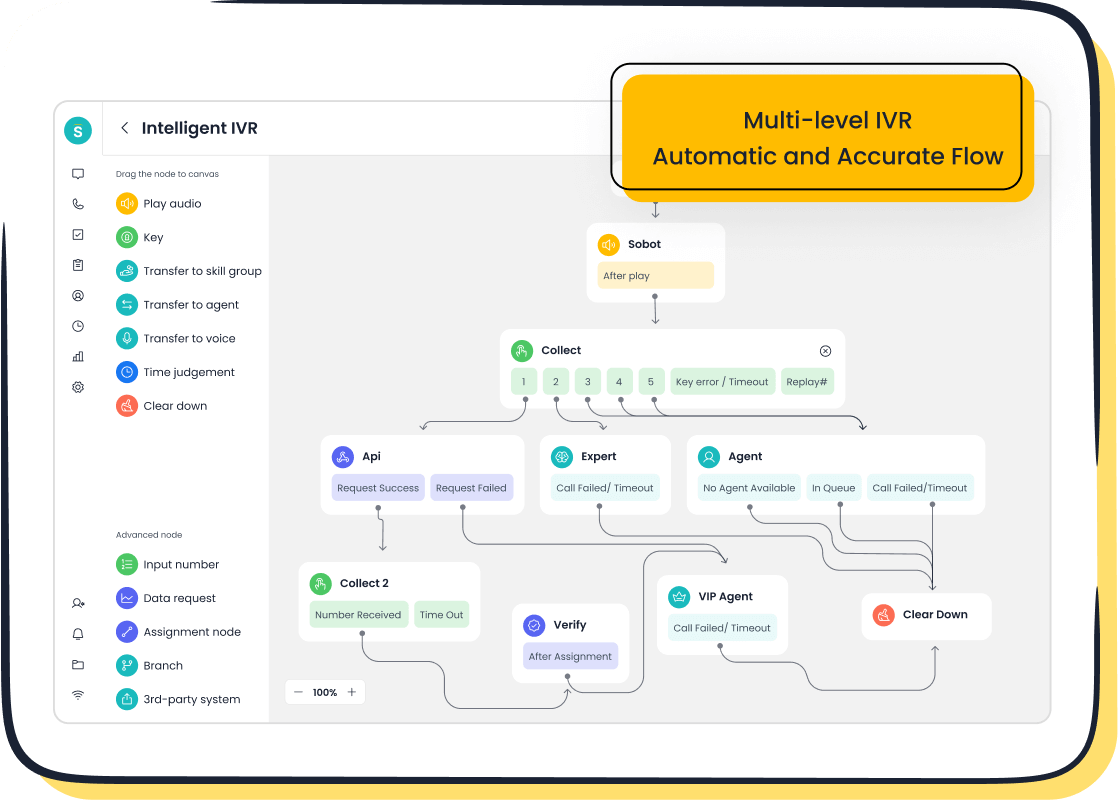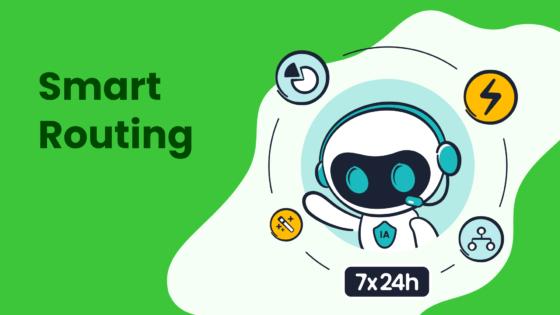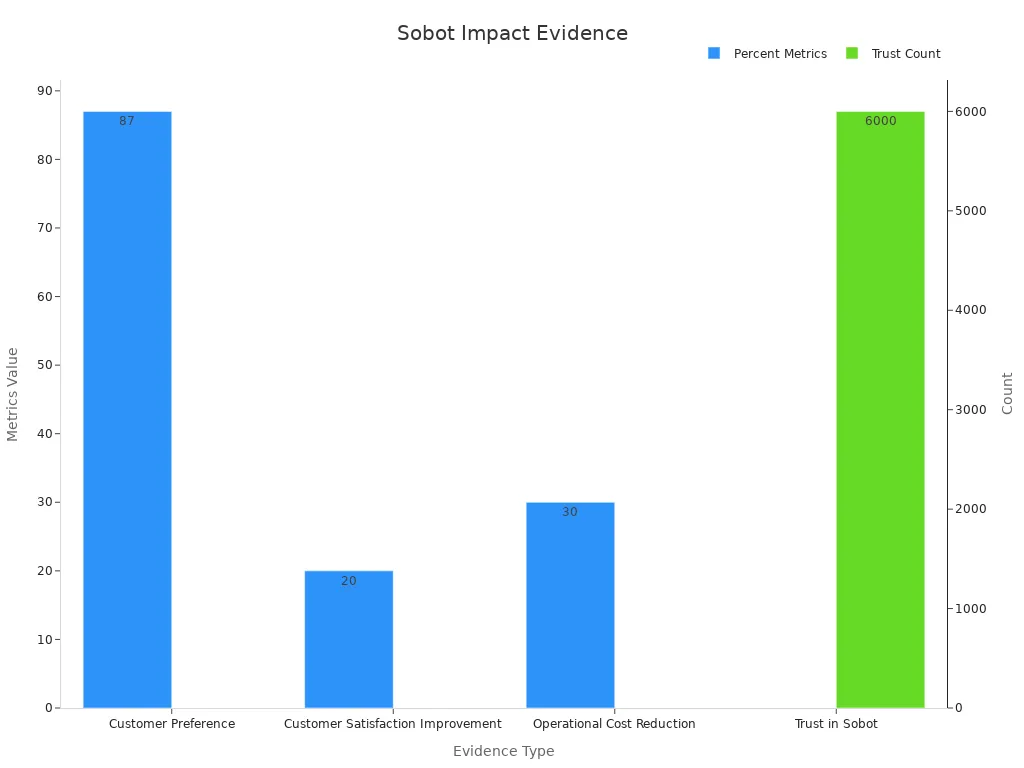What Is Customer Effort Score (CES) and How It Impacts Customer Loyalty

Customer Effort Score (CES) evaluates how simple it is for customers to engage with your business. This critical metric highlights the effort customers invest during their journey, whether resolving issues, making purchases, or seeking support. Studies reveal that minimizing customer effort significantly enhances loyalty. For example:
- Customers who experience effortless interactions are more likely to return and advocate for your business.
- Reduced effort drives repeat purchases and fosters positive word-of-mouth.
- High CES scores demonstrate your dedication to convenience and service excellence.
Sobot recognizes the importance of ces customer effort score in building loyalty. Its innovative solutions, such as the Voice/Call Center, streamline customer interactions with features like smart call routing and AI-powered voicebots. By focusing on simplicity and efficiency, Sobot empowers businesses to strengthen customer relationships and achieve long-term success.
Understanding Customer Effort Score (CES)

What is CES Customer Effort Score?
Customer Effort Score (CES) measures how easy it is for your customers to interact with your business. It evaluates the effort they need to resolve issues, complete purchases, or get support. Unlike other metrics that focus on satisfaction or loyalty, CES zeroes in on the ease of use during specific interactions. For example, when a customer contacts your support team, CES assesses whether the process was smooth or frustrating.
To calculate CES, businesses typically use surveys that ask customers to rate their experience on a scale, such as "How easy was it to resolve your issue today?" The responses are averaged to produce a score. Tracking this score over time helps you identify trends and areas for improvement. Factors like resolution time, the number of agent interactions, and wait times often influence customer effort scores.
| Parameter | Description |
|---|---|
| Customer Interaction Effort | Measures the effort required by customers to interact with a company or use its products/services. |
| Survey Types | Various surveys are used to measure CES, reflecting customer experiences. |
| CES Calculation | Average of responses calculated by total sum of responses divided by the number of responses. |
| Tracking Over Time | Importance of monitoring CES scores over time to assess improvements or declines in customer experience. |
| Average Resolution Time | Time taken to resolve customer care issues, correlating with perceived effort. |
| Agent Touches | Number of customer service representatives a customer interacts with to resolve an issue. |
| Request Wait Time | Time taken for an initial response after a customer creates a ticket or starts a chat. |

Sobot’s Voice/Call Center simplifies customer interactions with features like smart call routing and AI-powered voicebots. These tools reduce wait times and improve resolution rates, directly impacting your CES.
How CES differs from other customer experience metrics
CES stands apart from other customer experience metrics like CSAT (Customer Satisfaction Score) and NPS (Net Promoter Score). While CSAT measures happiness and NPS gauges loyalty, CES focuses solely on the effort required during specific interactions. This makes it a transactional metric rather than a relational one.
| Metric | Description | Measurement Type | Purpose |
|---|---|---|---|
| CSAT | Measures customer happiness with a specific interaction or overall | Relational and transactional | Reflects overall satisfaction and can predict customer retention |
| CES | Measures the ease of solving customer problems | Transactional | Focuses on effort required in specific interactions, indirectly affecting satisfaction |
For instance, a high CSAT score might indicate that customers are happy overall, but it doesn’t reveal whether they found the process easy. CES fills this gap by highlighting friction points in your customer journey. By analyzing CES data, you can uncover actionable insights to streamline processes and improve the overall experience.
Sobot’s omnichannel solutions, like its unified workspace, help businesses manage interactions across multiple channels. This reduces the complexity customers face, ensuring a seamless experience that positively impacts CES.
Why CES focuses on effort rather than satisfaction
Focusing on effort rather than satisfaction stems from a simple truth: customers value ease. Research shows that 96% of customers who face high-effort experiences become disloyal, while low-effort interactions build loyalty, encourage repeat purchases, and drive positive referrals.
| Evidence Description | Key Insight |
|---|---|
| High Effort Service Interactions = Lost Customers | 96% of customers who face high-effort service experiences become disloyal. |
| Low Effort Builds Loyalty | Low-effort experiences lead to higher retention, more spending, and positive referrals. |
| CES Predicts Future Purchase Behavior | Low effort indicates likelihood of repeat purchases, while high effort signals potential churn. |
By reducing customer effort, you not only improve satisfaction but also foster long-term loyalty. For example, Sobot’s AI-powered Voicebot handles repetitive queries efficiently, allowing your agents to focus on complex issues. This reduces the number of agent touches and ensures faster resolutions, directly lowering customer effort.
When you prioritize ease, you create a frictionless experience that keeps customers coming back. CES provides the clarity you need to identify and eliminate barriers, ensuring your business remains customer-centric.
Why Customer Effort Score Matters for Customer Loyalty
The link between effort and customer satisfaction
Customer satisfaction often hinges on how easy it is for customers to interact with your business. Research by the Corporate Executive Board (CEB) shows that reducing customer effort leads to higher satisfaction levels. Customers who experience smooth interactions are more likely to return, make repeat purchases, and recommend your business to others.
High-effort experiences, on the other hand, create frustration and drive customers away. For example, if a customer has to navigate multiple steps to resolve an issue, their satisfaction drops significantly. By focusing on ease of use, you can eliminate these barriers and enhance the overall experience.

Sobot’s Voice/Call Center helps businesses achieve this by offering features like smart call routing and AI-powered voicebots. These tools reduce wait times and streamline issue resolution, ensuring customers encounter minimal effort during interactions.
CES as a predictor of customer loyalty and retention
Customer Effort Score is a powerful predictor of loyalty and retention. Studies reveal that CES is 40% more accurate at forecasting customer loyalty compared to traditional satisfaction metrics. Customers who face low-effort interactions are more likely to stay loyal, while 96% of those who encounter high-effort experiences become disloyal.
| Evidence | Description |
|---|---|
| Customer effort's predictive accuracy | Customer effort is 40% more accurate at predicting customer loyalty than satisfaction. |
| Disloyalty rates | Ninety-six percent of customers with high-effort experiences become disloyal. |
| Effort as a driver | Effort is the strongest driver of customer loyalty. |
By analyzing CES data, you can identify pain points and take actionable steps to reduce customer effort. Sobot’s omnichannel solutions provide real-time insights that help businesses optimize their processes and improve retention rates.
Benefits of using CES in customer experience strategies
Integrating CES into your customer experience strategy offers several benefits. Lower CES scores correlate with higher retention rates, improved net profits, and better market performance. For example:
- Telecommunications companies have reduced support calls by 30% after using CES insights to streamline issue resolution.
- Retail businesses have optimized their returns process based on CES feedback, leading to lower operational costs and higher satisfaction.
Sobot’s solutions, such as its unified workspace, simplify customer interactions across multiple channels. This reduces complexity and ensures a seamless experience, helping businesses achieve lower CES scores and stronger customer loyalty.
Measuring and Calculating CES
Types of CES survey questions
To measure customer effort effectively, you need to ask the right questions. CES surveys typically focus on the ease of completing specific tasks or resolving issues. Common question formats include:
- Numbered Polls: Ask customers to rate their experience on a scale, such as 1 to 7 or 1 to 10. For example, "How easy was it to resolve your issue today?"
- Likert Scales: Use statements like "The company made it easy for me to solve my problem," and let customers agree or disagree on a scale.
- Emoticons: Include happy, neutral, and unhappy faces to gauge customer sentiment visually.
These questions help you capture customer effort scores and identify areas for improvement. Sobot’s Voice/Call Center enhances survey responses by reducing wait times and simplifying issue resolution, ensuring customers rate their experience positively.
Best practices for timing CES surveys
Timing is crucial when measuring customer effort scores. Surveys should be sent immediately after key interactions to capture accurate feedback. Here are some best practices:
- Trigger CES surveys right after a customer completes a purchase or receives support.
- Send automated surveys following a customer service call to assess the resolution process.
- Conduct surveys post-delivery or installation to evaluate the ease of those experiences.
For example, if a customer uses Sobot’s AI-powered Voicebot to resolve an issue, sending a survey immediately afterward ensures you capture their real-time reaction. This approach helps you analyze CES data effectively and make informed decisions to improve customer experience.
Methods for calculating CES scores
Customer effort score calculation involves straightforward methods supported by research. You can use these approaches:
- Average Score: Add all CES ratings and divide by the number of responses.
- Positive vs. Negative Responses: Subtract the percentage of negative responses from positive ones.
- Scaled Calculation: Divide positive responses by total respondents and multiply by 10 or 100.
For example, if 80% of customers rate their experience positively and 20% negatively, the CES score would be 60%. Harvard Business Review found that high effort is the leading cause of customer churn, emphasizing the importance of reducing customer effort. Sobot’s solutions, such as its unified workspace, simplify interactions across channels, helping businesses achieve lower CES scores and higher customer loyalty.
Interpreting CES Results for Actionable Insights
What constitutes a good Customer Effort Score?
A good Customer Effort Score (CES) reflects how effectively your business minimizes customer effort during interactions. While there is no universal benchmark for CES, its effectiveness lies in comparing scores within your industry or tracking your progress over time. For example, in the restaurant industry, CES is considered the most reliable metric for evaluating customer feedback. However, other industries may rely on metrics like NPS or CSAT, emphasizing the need for context-specific comparisons.

To determine if your CES is strong, focus on trends rather than isolated numbers. A consistently improving score indicates that your efforts to simplify customer interactions are working. Tools like Sobot’s Voice/Call Center can help you achieve this by reducing wait times and streamlining issue resolution. These features directly contribute to lowering customer effort and improving your CES.
Identifying pain points from CES feedback
CES feedback provides valuable insights into areas where customers face challenges. To identify pain points effectively, you can use data-driven techniques such as:
| Technique | Description |
|---|---|
| Segment your data | Analyze CES scores across various channels and customer segments to uncover specific pain points. |
| Identify trends | Look for patterns in CES data to find areas of high or low customer effort. |
| Analyze open-ended feedback | Review customer comments to extract common themes and pain points. |
| Prioritize areas for improvement | Focus on areas that will significantly enhance customer satisfaction based on the analysis. |
For instance, segmenting your CES data by channel might reveal that customers find phone support easier than email. Sobot’s omnichannel solutions, which unify customer interactions, can help address these discrepancies. By consolidating data and providing real-time insights, you can pinpoint and resolve friction points more effectively.
Using CES data to prioritize improvements
CES data serves as a roadmap for prioritizing customer experience improvements. Strategic models like Kano and RICE can help you decide where to focus your efforts:
| Model | Description |
|---|---|
| Kano | Plots CX initiatives based on 'impact' and 'effort' to prioritize those with low effort and high impact. |
| RICE | Uses scores based on reach, impact, confidence, and effort to prioritize CX initiatives effectively. |
To maximize the impact of CES data, regularly collect customer feedback and track key metrics. For example, if your CES reveals that customers struggle with long wait times, implementing Sobot’s smart call routing can significantly reduce these delays. This approach not only improves your CES but also enhances overall customer satisfaction.
By leveraging CES insights, you can focus on reducing customer effort in areas that matter most. This ensures a seamless experience that fosters loyalty and drives long-term success.
How CES Impacts Customer Loyalty and Retention
The connection between reduced effort and increased loyalty
Reducing customer effort directly strengthens loyalty. When customers find it easy to interact with your business, they are more likely to return and recommend your services. Studies show that a 42% reduction in resolution time significantly boosts satisfaction and loyalty. Customers who experience low-effort interactions are 94% more likely to make repeat purchases. Conversely, high-effort experiences discourage loyalty, with 61% of such customers unlikely to return.
Low-effort interactions also increase repurchase intentions by up to 96%. For example, simplifying processes like issue resolution or product returns can lead to a 12% increase in customer retention. These statistics highlight the importance of reducing customer effort to foster long-term loyalty. By focusing on ease, you create a seamless customer experience that encourages repeat engagement and builds trust.
Examples of CES driving customer retention
Customer Effort Score (CES) plays a pivotal role in improving retention rates. Businesses that prioritize reducing effort often see measurable outcomes. For instance:
- Companies that enhance onboarding programs and provide excellent training report higher retention rates.
- Lower customer effort correlates with improved renewal rates and increased customer lifetime value.
- Businesses that streamline their support processes often experience significant improvements in retention.
These examples demonstrate how tracking customer effort score can guide businesses in identifying friction points and implementing effective solutions. By addressing these areas, you can create a smoother customer journey that encourages loyalty and long-term engagement.
How Sobot's Voice/Call Center helps reduce customer effort

Sobot's Voice/Call Center offers advanced features designed to minimize customer effort. The platform's smart call routing ensures that customers connect with the right agent quickly, reducing wait times. AI-powered voicebots handle routine inquiries efficiently, allowing agents to focus on complex issues. This automation has reduced response times by up to 3 hours, leading to a 25% increase in customer satisfaction.
The system also improves response accuracy by 5%-15% and reduces the workload for maintaining the knowledge base by 80%. These capabilities not only enhance the customer experience but also empower your team to deliver faster resolutions. By leveraging Sobot's technology, businesses can achieve lower CES scores, higher retention rates, and stronger customer loyalty.
Strategies to Improve Customer Effort Score

Streamlining processes and reducing complexity
Simplifying your processes is one of the most effective ways to improve your CES. Customers value efficiency and clarity. When you reduce unnecessary steps, you create a low-effort experience that fosters loyalty. For example, businesses that streamline their checkout processes often see higher conversion rates. Similarly, simplifying returns or support workflows can significantly enhance the customer experience.
Start by identifying bottlenecks in your customer journey. Use CES feedback to pinpoint areas where customers face challenges. Then, focus on eliminating redundant steps and automating repetitive tasks. For instance, Sobot’s omnichannel solutions unify communication channels, allowing customers to interact seamlessly across platforms. This reduces complexity and ensures a smoother experience.
Enhancing customer support with Sobot's Voice/Call Center
Improving customer support is crucial for reducing customer effort. Sobot's Voice/Call Center offers advanced features that make interactions faster and more efficient. Smart call routing connects customers to the right agent immediately, while AI-powered voicebots handle routine inquiries. These tools not only reduce wait times but also improve resolution accuracy.
The impact of these features is significant:
| Evidence Type | Statistic/Fact |
|---|---|
| Customer Preference | 87% of customers prefer AI-driven self-service options |
| Customer Satisfaction Improvement | 20% increase in customer satisfaction with AI tools |
| Operational Cost Reduction | 30% reduction in operational costs with AI tools |
| Trust in Sobot | Over 6,000 companies trust Sobot for customer service |

By leveraging these capabilities, you can provide a low-effort experience that keeps customers satisfied and loyal.
Leveraging technology to improve customer interactions
Technology plays a vital role in reducing customer effort. AI-driven tools, augmented reality (AR), and virtual reality (VR) are transforming how businesses engage with customers. For example:
- AI-driven devices enhance interactions through smarter personal assistants.
- AR and VR create immersive experiences, benefiting industries like retail and education.
- Wearable health tech, such as smartwatches, improves engagement in personal wellness.
Sobot integrates cutting-edge technology into its solutions. Its AI-powered voicebots and unified workspace simplify interactions, ensuring customers receive quick and accurate support. These innovations not only improve CES but also elevate the overall customer experience.
By adopting advanced technologies, you can stay ahead of customer expectations and deliver seamless, efficient service.
Challenges and Limitations of CES
Common pitfalls in measuring CES
Measuring Customer Effort Score (CES) can be tricky if you don’t avoid common mistakes. Poor survey design often leads to inaccurate results. For example, failing to segment user groups properly can skew your data. Timing also plays a critical role. If you send surveys too late or at irrelevant moments, the feedback may not reflect the actual experience.
Another issue arises when surveys are too lengthy or unclear. Customers prefer quick responses. A well-designed CES survey should take no more than five seconds to complete. Additionally, triggering surveys immediately after a transaction ensures you capture relevant feedback. Segmenting surveys by user profiles or tasks also helps you gather more precise insights. For instance, if users report confusion during profile setup, it indicates friction in the process that needs attention.
Sobot’s omnichannel solutions simplify survey management. By integrating CES surveys into its unified workspace, Sobot ensures you collect timely and accurate feedback across all channels.
Limitations of CES as a standalone metric
While CES is valuable, it has its limitations. It focuses solely on service-specific interactions, which means it doesn’t provide a complete picture of your business performance. For example, CES can tell you if customers found a process difficult, but it won’t explain why or what caused the difficulty.
| Limitation | Description |
|---|---|
| Service Specific | CES measures ease of service but doesn’t reflect overall business health. |
| Lack of Detail | It highlights friction but doesn’t identify the root cause of the problem. |
To address these gaps, you should pair CES with other metrics like NPS or CSAT. This combination provides a more comprehensive view of customer experience. Sobot’s Voice/Call Center, with its real-time analytics, helps you analyze CES alongside other metrics, offering deeper insights into customer behavior.
Balancing CES with other customer experience metrics
Relying solely on CES can limit your understanding of customer needs. Balancing CES with metrics like NPS and CSAT gives you a broader perspective. While CES measures effort, NPS evaluates loyalty, and CSAT gauges satisfaction. Together, these metrics help you identify trends and prioritize improvements effectively.
For example, if your CES indicates high effort during support calls, but your NPS remains strong, it suggests customers value your service despite the challenges. Sobot’s AI-powered Voicebot reduces effort by handling repetitive queries, improving both CES and CSAT scores. By leveraging such tools, you can create a seamless experience that enhances satisfaction and loyalty.
Balancing these metrics ensures you address customer pain points while maintaining a holistic view of their journey. This approach helps you build stronger relationships and drive long-term success.
Customer Effort Score (CES) plays a vital role in customer experience management. It helps you understand how easy it is for customers to interact with your business. Reducing effort strengthens loyalty and increases retention rates. For example, businesses that simplify processes often see higher satisfaction and repeat purchases.
Prioritizing CES ensures you focus on creating seamless experiences. Tools like Sobot’s Voice/Call Center simplify interactions, reduce wait times, and improve resolution accuracy. By integrating CES into your strategy, you can foster loyalty and drive long-term success.
FAQ
What are customer effort score questions?
Customer effort score questions measure how easy it is for customers to complete tasks or resolve issues. For example, "How easy was it to solve your problem today?" These questions help businesses identify friction points and improve customer experience. Sobot’s Voice/Call Center simplifies interactions, ensuring positive survey responses.
How can CES improve customer retention?
CES highlights areas where customers face challenges. By reducing effort, you increase satisfaction and loyalty. For instance, Sobot’s AI-powered voicebots handle repetitive queries, allowing agents to focus on complex issues. This approach lowers effort and boosts retention rates.
When should you send CES surveys?
Send CES surveys immediately after key interactions, such as support calls or purchases. Timely feedback ensures accurate insights. Sobot’s omnichannel solutions automate survey triggers, helping you collect real-time data across multiple channels.
Can CES be used with other metrics?
Yes, CES complements metrics like NPS and CSAT. While CES measures effort, NPS gauges loyalty, and CSAT evaluates satisfaction. Together, these metrics provide a comprehensive view of customer experience. Sobot’s unified workspace integrates these metrics for deeper insights.
How does Sobot help reduce customer effort?
Sobot’s Voice/Call Center offers smart call routing and AI-powered voicebots. These tools reduce wait times and improve resolution accuracy. By simplifying interactions, Sobot helps businesses achieve lower CES scores and stronger customer loyalty.
See Also
Comparative Analysis of Leading Customer Feedback Tools
Enhancing Online Shopping Experience with Chatbot Technology
Increasing Operational Efficiency with AI Customer Support
